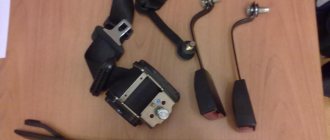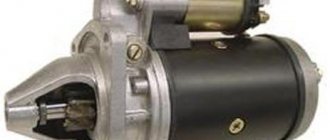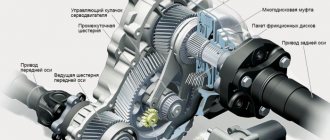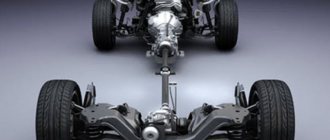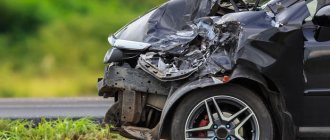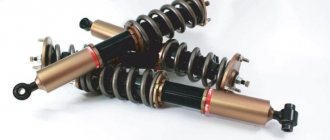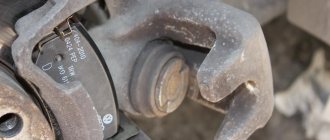Nowadays, cars are equipped with a significant number of safety systems and equipment. They are aimed at preventing loss of control of the car during emergency situations (active systems) and the maximum possible reduction in injury to passengers during an accident (passive means).
It all started with seat belts, which “migrated” to vehicles from aviation. The first prototypes of belts appeared almost with the beginning of the automobile era itself. In 1903, the first version of such a car security system was proposed, but then it did not catch on. They became more actively interested in them in the 50s of the last century. Moreover, at first, belts were offered only as an option and only a little later - as standard equipment.
It is worth noting that at one time the designers tried to replace the belts with another system - airbags. But later it turned out that using airbags on their own is of little use, but in combination with belts they seriously increase safety.
In general, seat belts are one of the “oldest”, but at the same time effective means of preventing injury, that is, they belong to a passive system.
WHAT IS A SEAT BELT CONSISTED OF?
The basic design of the seat belt consists of:
- straps;
- castle;
- fastening bolts;
- retractor device.
For the production of straps, synthetic material is most often used. The main requirement for it is a high level of strength. The seat belt retractor operates using a ratcheting mechanism. Emergency blocking occurs due to the sensitive element.
The basis of the sensitive element is a simple metal ball. When it moves, the reel is fixed by a system of levers. Some designs use a pendulum instead of a ball.
Separately, we need to talk about the system responsible for the gradual tension of the tape. This happens thanks to the flywheel. It is mounted on the spool axis. This is a small disk that ensures a smooth process. But if an accident occurs, a jerk is formed, due to which the disk has to overcome the friction force. At the same time, pressure arises on the screw surface.
Attention! As a result of the actions described above, the disk moves and the ratchet locks.
The seat belt device helps ensure the safety of passengers during collisions. But even they have a certain limit of effectiveness. At speeds over 200 kilometers per hour, the belts will be of little use.
The bolts in the seat belt device are responsible for reliable fastening of the entire structure while driving. They are made of hard alloy that can withstand heavy loads. Moreover, they are attached to the car frame to ensure maximum reliability.
Design features and varieties
Seat belts began to be installed on cars at the dawn of the automotive industry. The first attempts to develop a simple protection device were made at the very beginning of the 20th century, but at that time they did not show decent results, and continuing research in this direction became impractical.
The second round of interest in this type of security mechanism appeared in the last century. The device was offered as an additional option, and not a mandatory element of the entire car design. Only after some time the strap began to be installed as basic equipment.
Automotive researchers have considered replacing belts entirely, and alternatively using only panel-firing airbags. But numerous tests have shown the low effectiveness of using pillows independently, as opposed to using them together.
Now seat belts (SB) have become an integral part of any car, which allow you to keep passengers in the seat, regardless of the emergency situation that has occurred.
The main component of the passive safety device is fibrous polyester tape. This material has characteristics that allow it to withstand high loads and is also less susceptible to mechanical stress and tearing. The strap holds the body in a fixed position, preventing it from moving forward in a frontal collision.
Another important fact is that the RB prevents the possibility of a motorist or passengers inadvertently flying out of the vehicle, and also ensures the impossibility of a collision with the structural elements of the car.
A complete RB design includes:
- fixed and movable safety equipment attachment points;
- lock;
- reels that have an inertial tension function that allows you to move smoothly on the seat;
- limiters;
- pretensioner
The above elements appeared as the automotive industry developed, and even today, not all cars have a passive safety system that combines each of them at the same time.
Installation and dismantling rules
How to remove a seat belt
Over time, the belts wear out and the fasteners break; to repair and replace them, the belts are removed. This has to be done at a car dealership, since the entire mechanism of the device will have to be completely removed. On some models, such as Toyota, the process affects deeper levels; you even have to remove the front wheels of the car.
For more details see the link
Installing seat belts
The installation of safety belts is carried out at the service center in accordance with the regulations - it is worth remembering that the new rules came into force in 2012 (clause 7.23 of the Technical Regulations). Some car owners were lucky - traffic inspectors did not immediately pay attention to whether the car was converted in accordance with the new requirements, but at the time of 2022, it is naive to expect that the traffic police representative will not notice this.
Seat belt repair
Belts wear out during use and may simply jam or become loose. Removing the mechanism and repairing it can be done with your own hands if you have certain skills, but owners of modern car models will have to go to a service center. Especially if the belt is equipped with a squib - climbing into such a device without the appropriate skill is dangerous.
Types and distinctive features
The key criterion by which RBs differ is the number of fixation points. This parameter is of fundamental importance and helps to minimize injuries during an accident.
The following types of RB exist:
- point-to-point,
- three-point,
- four-point,
- five-point,
- multipoint.
It is important to note that the number of fixation points often makes the use of a safety belt insufficiently comfortable, but increases the likelihood of injury.
2-point
The two-point seat belt was one of the first to be installed on production vehicles (TS). The effectiveness of this type showed the least results. In total, 2 types of RB such fastening systems are provided.
In the first option, the passenger is fixed in the lumbar region transverse to the seat. One mount was located in the sill or side pillar area, and the other was located between the front seats. For the convenience of fixing the RB, the security system included a lock with a latch.
The disadvantage of the design is that the strap only held the lumbar region, and in an accident the person continued to move the upper part of the body by inertia in the direction of the steering column or panel. Thus, it is simply impossible to avoid injury, although it is possible to keep the body from flying out.
The option with a chest strap provided for the installation of fasteners on the side pillar and between the front seats. In the event of a collision, the RB guaranteed the retention of the body, but the likelihood of the person fastened slipping under the belt increased, which also contributed to the high incidence of injuries.
3-point
Most modern vehicles use three-point seat belts, given that such a system is considered the most practical to use and eliminates the possibility of further movement of the fastened person in a collision due to inertia.
This type of design has three clamps - two points in the side pillar, and 1 with a lock between the seats.
The mounting point on the side of the vehicle pillar is fixed, and the other is equipped with a coil to automatically return the vehicle to its original state. A movable lock tongue is attached to the RB for easy fixation of the seated person. This design combines two types of 2-point seat belt at the same time.
The sliding tongue for the lock allows you to sit comfortably in the seat and, in one motion, secure your body in a stationary state in case of an emergency.
4-point
The four-point mounting system is rarely used on budget or low-performance cars, and is often only seen on racing or sports vehicles.
Due to the inconvenience of use, it is not widely popular. The attachment points in such a device may vary. One of the types includes vertical straps with a fixed one-piece fastening and one detachable one in the lumbar area. A special feature of this system is that the vertical straps are not attached to the structural elements of the body, but directly to the seat.
Before getting into cars, you will first need to put 2 straps over your shoulders, after which you need to stretch and secure the lumbar belt.
The second version of the system provides fixed vertical straps that can be freely detached. Each of them has a tongue for installation in the lock.
Types of modern seat belts
As seat belts began to be introduced into the automotive industry, manufacturers began to offer different types of these devices. As a result, in modern cars you can find several categories of belts:
- Two-point belts are an obsolete option. Such devices are most common in passenger buses and airplanes. Sometimes two-point belts are installed in the rear seats of cars for the passenger sitting in the middle.
- A three-point belt is an option familiar to most car owners. It is also called diagonal-waist. It has a secure fit and is universal (suitable for both the front and rear rows of seats in any car).
- Four-point harnesses are not a widely used type. Most often they are used on sports cars, special equipment, and sometimes on SUVs. The belt is attached to the seat at four points, keeping the person from tipping over or getting hit hard.
- Five-point belts are used only in expensive supercars, as well as in the design of child restraints. In addition to the shoulder and waist fastenings, another belt is installed, located between the passenger’s legs.
Four-point belts can be found in racing cars and sports cars.
5-point
Five-point seat belts, like the previous type, are widely used in sports vehicles, as well as in car seats for children.
In terms of its structure, it is the same 4-point belt with an additional strap. The auxiliary element is located at the bottom of the seat - between the legs, and is placed in a special lock.
This type of protection guarantees the most reliable retention of the body, and also allows you to distribute the load evenly across the belts.
What can you pay attention to when choosing a belt?
- Components. It should be noted that each car has an individual security system structure, which may differ on different models.
- Fasteners The fundamental element in the passive safety system is the fastener, since it ensures the strength of the structure. Fasteners are mounted on body elements, since at the moment the body moves by inertia with acceleration, a colossal impact is exerted on the belt.
If the fastenings were mounted in the seat, then excessive loads could simply destroy the integrity of the structure, since the backrest moves along with the body.
When installing the mount into the body, such displacement cannot occur. The exception is cases when the impact leads to a total violation of the integrity of the body. The fastening system may provide for fixing the belt directly into the seat. This design is typical in sports cars, where the seats for the driver and passenger initially provide for the impact of enormous loads, for this reason such fasteners are possible. The lumbar belt is attached exclusively to the body.
Operating rules
Using a seat belt is as simple and convenient as possible for the driver and passengers. However, even this simple device has its own rules and operating nuances.
- To check if the seat belt is tight enough, place your hand between the belt strap and your body. If there is a noticeable compression on the hand, it means it is tensioned to the required extent.
- Do not allow the tape to twist. In addition to the obvious inconvenience, such operation of the belt will not provide it with proper tension in an emergency.
- If the car was sent for repairs after a serious accident, ask the service specialists to pay attention to the seat belts. As a result of strong and sudden tension, the tapes could lose their strength. It is possible that they need to be replaced, and also check the reliability of fastening of all elements of the device.
- It is recommended to replace seat belts even during accident-free driving at intervals of 5-10 years due to natural wear and tear.
Many motorists try to loosen the belt so that it does not hinder movement. However, an unreasonably weak tension significantly reduces the braking effect of the device, which is why its effectiveness is significantly reduced.
In the event of an accident, an unbelted driver and his passengers can suffer more serious injuries, which are often incompatible with life.
Statistics say that if a person ignores the need to wear a seat belt in a car, then in the event of an accident the risk of serious injury will increase:
- 2.5 times - in a frontal collision;
- 1.8 times – in case of a side impact;
- 5 times - when the car rolls over.
The road can be completely unpredictable, so seat belts can save your life at any time.
Ease of use
Speaking about ease of use, it should be noted that vertical belts are suitable for a person of any build and height, in contrast to belts with a diagonal attachment point in the body.
A diagonal belt with fastening in the body can pass almost in the neck area of a short driver. This circumstance indicates not only inconvenience, but also unsafe operation, since at the moment of a collision the inertial force and tension of the belt will act on the person’s neck. This results in a high probability of injury and significant harm to health.
For tall people, a diagonal position of the belt with an attachment point in the body is also not always suitable, since the strap passing below the shoulders can significantly restrict the movements of the arms.
Manufacturers of modern cars have taken care of this and have provided the possibility of moving the body mount in height for optimal adjustment to the seated person.
Coin inserted into belt buckle
The so-called “plug” is not the first invention of car enthusiasts who do not like to wear seat belts. It’s just that recently car manufacturers have begun to make it so that no other object can be inserted into the lock. In old cars, with old equipment, enterprising car enthusiasts would put a coin in there. This trick does not work on new models. There is a myth that an airbag will save you in any case and therefore it is not necessary to fasten your seat belt. But this is pure delusion. In fact, it is not uncommon for people to be killed not by injuries from an accident, but by the pillow itself.
Lock part
The detachable design element of the fastening point provides a convenient location of the seat belt straps.
The principle of operation is simple - a metal tongue with a hole, attached to the belt, is inserted into the lock hole and secured with a pin to fasten the structure. There is a button on the lock body that retracts the pin and separates the elements.
The key to the effective operation of the entire passive safety system is the correctly adjusted RB tension. Previously, each driver or passenger was required to adjust the straps to suit their body size. If the driver had to do this quite rarely, then the passenger must carry out the adjustment constantly.
With the advent of inertial reels in the design, the issue of constant belt length settings was resolved forever. The car seat belt device automatically tensioned the belt so that the passenger or driver could fit comfortably in the seat.
The main feature of the reel is the function of blocking the belt if you try to sharply pull the tape out of the device. The mechanism will not allow you to quickly unwind the coil, preventing the person sitting in the seat from shifting due to inertia when the car suddenly stops.
The inertial coil performs 3 main functions:
- provides the necessary belt tension, adapting to the body composition of the seated person;
- automatically collects the belt after it is unfastened;
- prevents involuntary movement of the body during sudden braking or stopping.
There is also a drawback - the mechanism technically does not have time to instantly respond to sudden tension. This allows the body to speed up a bit in an emergency, which significantly increases the likelihood of injury.
Limiters
The main function of the limiter is an insignificant and smooth increase in the length of the seat belt.
During emergency braking or a collision, the body continues its inertial movement, being subjected to significant overloads. Seat belts that are not equipped with limiters instantly stop the vector of movement, injuring the chest, neck or lumbar region of a person.
A gradual and smooth increase in the length of the belt allows you to reduce the speed of inertial movement, while reducing the likelihood of injury.
The limiter has the form of a torsion bar, which acts as an axis for the coil. When triggered, the reel stops the unwinding of the belt, the body rests against the belt, creating a load on the belt.
Components and their purpose
Please note that not all components may be included in the design of safety equipment on certain models.
Fasteners
Let's start with the attachment points. They are often installed on body elements. This is due to the fact that the human body at the moment of inertial displacement forward creates a significant load on the belt. If you use an attachment point built into the seat, the structure may not be able to withstand the heavy load, and the backrest will move along with the body. In the case of mounting to the body, this will not happen.
But in devices with four or more points, some of them are still mounted in the seat (vertical straps). At the same time, we note that the design of seats in sports cars is much stiffer and is designed to withstand heavy loads, which is why it is possible to install fasteners in them. But as for the fastening of the lumbar strap, it is fixed to the body.
Now regarding the convenience of the attachment points (applies to the upper ones). The seat belts are comfortable because they extend above the shoulders. But the points on the counter can cause discomfort. If it is in a high position for short people, the diagonal part of the belt will run almost along the neck, which is not only inconvenient, but also unsafe. And for tall people, a low position of the top point will ensure that the belt passes below the shoulder, which will restrict arm movements. Therefore, manufacturers make the upper mounting points on the racks adjustable. No adjustment is required on fasteners located on the seats.
Lock
The lock provides a detachable fastening point. It also ensures the convenience of laying the straps. The operation of the lock is very simple - a hole is made on the tongue located on the belt, and a pin is used in the lock. When installing the tongue, the pin fits into the hole, thereby ensuring reliable fixation. To disconnect, you just need to press the special lock key to retract the pin and release the tab.
Inertia coils
The effectiveness of belts largely depends on their correct tension. Previously, for this it was necessary to adjust the length of the straps “to suit you” using special loops. This did not particularly cause problems for the driver, since he only needed to adjust the belt once. But passengers with different builds had to make adjustments every time.
Inertia reel mechanism
This problem disappeared with the advent of inertial coils. It provided automatic rewinding of the tape so that it would not interfere. You can only pull it back with a smooth movement. It is impossible to unwind the strap sharply with such a reel, since the mechanism blocks it during rapid unwinding.
Using an inertial reel solved several problems at once - when unfastened, the tape rewinds itself, which is very convenient. The reel also independently adjusts the tension by selecting the excess part of the belt. Another positive quality is that the reel locks during sudden unwinding. It prevents the belt from unwinding, so it “catches” the body, preventing it from moving forward too much. But there is also a negative quality - it is not blocked immediately, and the length of the belt still increases slightly, which is why the body has time to gain a slight acceleration. And this increases the likelihood of injury.
Limiters
The limiters allow you to slightly increase the length of the belt, but smoothly. The point is this: the body experiences significant overloads during inertial deflection. If you stop it abruptly, which is what the belt does, you may get injured. But if the strap slightly increases its length, this will partially absorb the energy and increase injury safety.
Torsion coil
The limiter is a torsion bar that acts as an axis for the coil. In the event of a collision, the reel blocks the unwinding of the belt, the body rests against the belt, which creates a load on the belt. When a certain force on the strap is reached, the torsion bar begins to twist, turning the reel and unwinding the belt. Because of this, a smooth release of force on the belt occurs. It is worth noting that the strap itself does the same. Polyester tape may stretch slightly when a significant load is placed on it.
Pretensioners
Pretensioners appeared on cars quite recently, but their role is significant. As already noted, the coil is not blocked immediately, so the body still receives acceleration. To prevent this, pretensioners are used, which tighten the belt even before the body begins inertial movement. That is, it prevents acceleration from being obtained. These devices work proactively and use impact sensors used in the design of airbags for this purpose.
Pretensioners work like this: at the moment of impact during a collision, sensors register it and send a signal to the control unit. That, in turn, engages the actuators, and they instantly tighten the tape, eliminating even the slightest forward movement of the body. There are two types of pretensioners - squib and electrically driven.
Electric pretensioner
Pre-tensioner element
Pretensioners began to be installed in seat belt designs several years ago, but their role should not be underestimated. As noted earlier, the reel cannot technically stop the unwinding of the belt instantly, which is why the body still manages to continue its inertial movement. It is to prevent this drawback that pretensioners were developed, tensioning the belt until the moment of a sharp stop and inertial movement of the body.
There are 2 main types of pretensioners.
- Squib cartridges.
- Electrically driven.
Here, the mechanical principle of operation alone is no longer sufficient. Advance tension of the belts is ensured by the activation of additional shock sensors that send a signal to the control unit, which are equipped in modern cars.
The most common breakdowns
Seat belt jammed
If you cannot pull the belt out of its socket, it means it is jammed. The problem can be eliminated on your own - most likely, the problem is in the latch - it is equipped with a special ball inside, which is responsible for the ease of movement of the belt in the mechanism. And it is with this that problems arise if the belt is pulled and pulled too sharply and quickly. Other reasons may include:
- freezing;
- accident.
In the latter case, you will not be able to deal with the problem yourself; only a service center mechanic will carry out the replacement.
General operating principle
It will take literally 1 minute for the driver or passenger to fasten their seat belts.
As an example, let’s consider a mechanism with a three-point fixation system, due to their mass and greatest prevalence. After the driver is seated in the car seat, it is necessary to smoothly pull the belt to the required length, directing the metal tongue into the hole in the lock.
Having heard the characteristic sound of a latch, you can release the belt, allowing the inertial reel to remove the excess length.
If the structure is equipped with pretensioners, then in an emergency it is they who begin their work:
- in the event of a collision, sensors located in the nose of the car will transmit the relevant information to the on-board computer, which activates the pretensioners to tighten the straps;
- As the load increases, the torsion bar comes into play, successively increasing the length of the strap to dampen acceleration.
If the design does not provide for the presence of the element in question, then their task is performed by the coil together with the torsion bar.
Belt pretensioners
The first in this area were squibs, which, receiving a signal from the control system, when triggered, tightened the seat belt, the length decreased, reducing that same dangerous distance. To prevent the tension from being critically strong, the tensioner design contained a force limiter, a device that, when the load on the chest was exceeded (approximately 150 kg), began to give slack, thereby weakening the belt’s dead grip. The only drawback of these devices was and remains their disposability. After activation, the squib must be replaced.
The system of electric tensioners is completely free of this drawback. They are able to perform this action repeatedly. Working in conjunction with radars and sensors, they are able to determine critical proximity even before the moment of collision, which means protecting passengers and the driver in advance. If the device detects a danger, the length of the belt is shortened and the person is securely fixed in the chair.
Recommendations
No one can ever know when an accident will happen. An analysis of a huge number of videos of road accidents suggests that the survival rate in serious accidents is many times higher for passengers who were using the RB at the time of the accident.
Situations cannot be ruled out when an unbelted driver simply flew out of the vehicle at the moment of the first impact, which saved his life, taking into account the likelihood of the vehicle subsequently moving along an unpredictable trajectory or overturning.
It is important to note that fastening your seat belt before driving is one of the requirements of the Russian Traffic Regulations, for ignoring which a fine is provided. This obligation is fully justified, since in many road accidents the cause of serious injury or death is the unfastened vehicle.
Another reason why you should spend 10-15 seconds on a passive airbag system is the likelihood of getting a concussion, a broken nose, or other damage to the area of the body that comes into contact with a deployed airbag, even in a minor accident.
It should be noted that the opening speed of the PB is more than 300 km/h. Add to this value the speed of inertial movement and the final result is a very noticeable blow, in which loss of consciousness will be the least consequence.
Repair process
Now that we have dealt with the signals and reasons for blocking a fastened and unfastened seat belt, let’s move on to the repair process. Cleaning seat belts is one of the main tasks in this process, so we will consider this procedure separately. So, what should you do if you receive a signal that the lock is jammed? How can I clean it or turn it off? You will learn more about this below.
Tools
To disable the lock if a corresponding signal appears, the entire mechanism will need to be cleaned. To do this, you need to thoroughly prepare in advance and collect all the necessary tools. so what to prepare:
- a Phillips screwdriver, preferably a short one;
- flat head screwdriver;
- a wrench set to “17”, it will be more convenient to use a socket wrench;
- stationery pin;
- syringe with tube;
- some gasoline (lighter fuel is ideal).
Step by step instructions
When the entire list of tools is ready, you can begin repairing and cleaning.
- Using a Phillips screwdriver, unscrew the screws that secure the strap protection.
- If the lock is not working, pull the strap out to its full length and secure it with a clothespin.
- Take a wrench and remove the screw that secures the element coil. The screw must be removed from its installation location. To prevent the element from starting to unwind, you can attach it directly to the same spool using the same clothespin. In any case, in order to disable and clean the lock, it must be locked to make further actions easier.
- Put the reel aside and sit in the next seat. To disable and clean the lock, you will need to find the lid behind which the inertial device is hidden. As a rule, it is slightly thicker in design. Shake the coil - under which cover you hear the noise - under that one it is located.
- Now to dismantle the protective cover you will need to remove four plastic pistons. This can be done using a slotted screwdriver or a thin knitting needle. The pistons should be supported by hand so that they do not fly out and you do not have to look for them and collect them throughout the cabin. Then pry up the cover with a screwdriver and remove it. Set the lid aside.
- Your view will now be presented with the first mechanism of the component. It is a kind of box with a cylinder and thus a locking ball and a so-called rocker inside, which jams the lock. This mechanism can be dismantled freely from the installation site.
- Check the functionality of this rocker - ideally it should move freely along the axis of rotation. This device should be positioned vertically with the top angled toward the locking ball. One way or another, the rocker arm must be positioned vertically so that it does not jam. If you feel that the so-called rocker arm does not move freely, then you need to clean its rotation axis. Pour some gasoline and rinse the device until it rotates freely on the axis, without the slightest jamming.
- Now let's move on to the second, inertial device. It is located under the gear, which is made of plastic and in most cases is made of steel. The gear comes off freely, so remove it.
- Note the center of the serrated hole. It contains an eccentric with teeth. It is these teeth that jam the strap when it is suddenly pulled out. The space under this very eccentric needs to be cleaned. Pour a little prepared gasoline around the entire perimeter of the hole, add a little fuel to the center. At the same time, hold the strap, preventing it from winding up, for which you can temporarily remove the clothespin. Make sure that the liquid gets into all parts of the element, otherwise cleaning it will be useless.
- Take the dismantled spool with one hand so that the plastic guide along with the spring can be supported with one finger. Using your other hand, pull and wrap the safety element several times. Also pull it a few times until the device itself engages. Next, hook it on the reel one more time. These steps should be repeated several times.
Innovations in passive safety
The world's leading automakers are working every day to improve all vehicle safety systems. A relatively recent innovation is pretensioners, but they are no longer new.
Innovative belts that simultaneously serve as airbags are already being actively tested.
The essence of the system is to instantly fill the belt with gas, which allows you to increase the area of contact between the belts and the body, as well as evenly distribute the load, reducing the likelihood of injury.
More expensive vehicle models in the future will be equipped with self-adaptive pretensioning systems that independently adjust to the physical parameters of the seated person. The computer calculates the required force to hold the body at the time of the accident.
New developments
Developments to improve this security feature are ongoing. The latest innovation widely used on cars is pretensioners. But they are not the latest technology.
Tapes are already being developed that also act as pillows. The bottom line is that upon impact, it is filled with gas, due to which the area of contact of the body with the strap increases, which helps to better distribute the load and reduce injury.
They are also developing an electronic self-adaptive pretensioner system; depending on the use and stretching of the strap, it determines, according to given algorithms, the weight of the passenger and, accordingly, the required force to hold him at the time of the accident.
